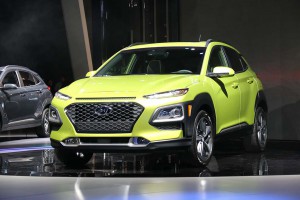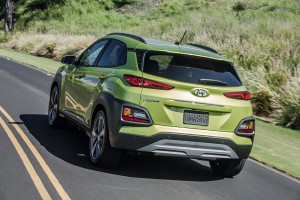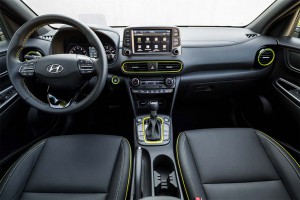Hyundai has a big gap in its small-car line-up, one it aims to fill with the debut of its new Kona crossover making its debut at the Los Angeles Auto Show.
One of eight new or substantially refreshed CUVs Hyundai plans to launch by 2020, the Kona fills a yawning gap below the current Tucson and Santa Fe models. And it finally lets Hyundai Kona take on competitors like the Jeep Renegade, Honda HR-V and the upcoming Ford EcoSport in what is expected to be one of the U.S. market’s fastest-growing segments over the next few years.
“We’re confident it will set new standards for its segment, with appealing design, cutting-edge connectivity and class-leading available safety features,” said Mike O’Brien, vice president of Product, Corporate and Digital Planning for Hyundai Motor America.
Like other products in the segment, Hyundai is targeting Millennials who want something solid and reliable that also delivers a good value. The Korean carmaker isn’t ready to talk price but a low price is just part of the selling proposition. Kona will also offer strong styling and lots of features for the segment, including LED headlamps, fog lamps, taillights and daytime running lights. It will also be offered with a range of the latest Advanced Driver Assistance Systems, or ADAS.
(Union strike could short-circuit critical launch of Kona in U.S. For the story, Click Here.)
Visually, the CUV projects a low and wide stance, Hyundai designers aiming to create a shape they describe as “urban smart armor.”
From the front, one spots the latest version of Hyundai’s cascading grille, with a sporty mesh pattern. The fenders create a more aggressive stance, something carried over into its profile where contrasting black cladding provide a hint of classic SUV flexibility and durability.
The new Kona is based on an all-new crossover platform set to be shared by several future Hyundai models. It provides higher ground clearance and is packaged to maximize both interior space, the new Kona delivering 19.2 cubic feet of rear cargo volume. Split-fold rear seats expand the available space and a dual-level load floor gives an extra three-inches of vertical space.
The passenger compartment also appears to be one of the more roomy designs, Hyundai boasting the new CUV has some of the best headroom in the segment despite the car’s relatively low roof line.
Designers opted for a relatively simple interior layout, with a standard seven-inch floating touchscreen that includes both Apple CarPlay and Android Auto capability. The two-tone interior gets piano black accents that yield a more premium feel.
(Hyundai rolls out Kona into booming utility vehicle market. For more, Click Here.)
Under the hood, the new Hyundai Kona is powered by a 2.0-liter 4-cylinder Atkinson cycle engine that produces 147 horsepower and 132 lb.-ft. of torque. Paired with a six-speed automatic transmission, the front-wheel-drive package delivers 30 mpg. An all-wheel-drive system also is available with the optional 1.6-liter turbo four that makes 175 hp and 195 lb-ft of torque.
Among options, the new Hyundai Kona will be offered with an 8-inch navigation system, rain-sensing wipers and a head-up display, or HUD.
Buyers will also be able to get an assortment of ADAS technologies, including rear cross-traffic alert, forward collision warning with auto braking, lane-keeping assist and blind-spot monitoring. They’ll be part of the Hyundai Smart Sense safety package.
The Kona could be one of the most important models Hyundai has brought out in several years. The brand was one of the fastest-growing in the American market earlier in the decade but has lost momentum as buyers by the millions have switched from passenger cars to light trucks. With only two models, the Santa Fe and Tucson, Hyundai simply didn’t have the breadth to compete with marques like Honda and Toyota. It hopes to get back in the game with offerings like the Kona and the other new and updated models to come.
(To see more about Hyundai’s plans to update its utility vehicle line-up by 2020, Click Here.)
One problem for Hyundai is that workers in Korea have gone on strike hoping to press their wage and employment demands. The carmaker had already lost over 1,000 units of production by midday Tuesday and it could find itself facing a shortage of the new crossover model if it doesn’t resolve the dispute quickly.



